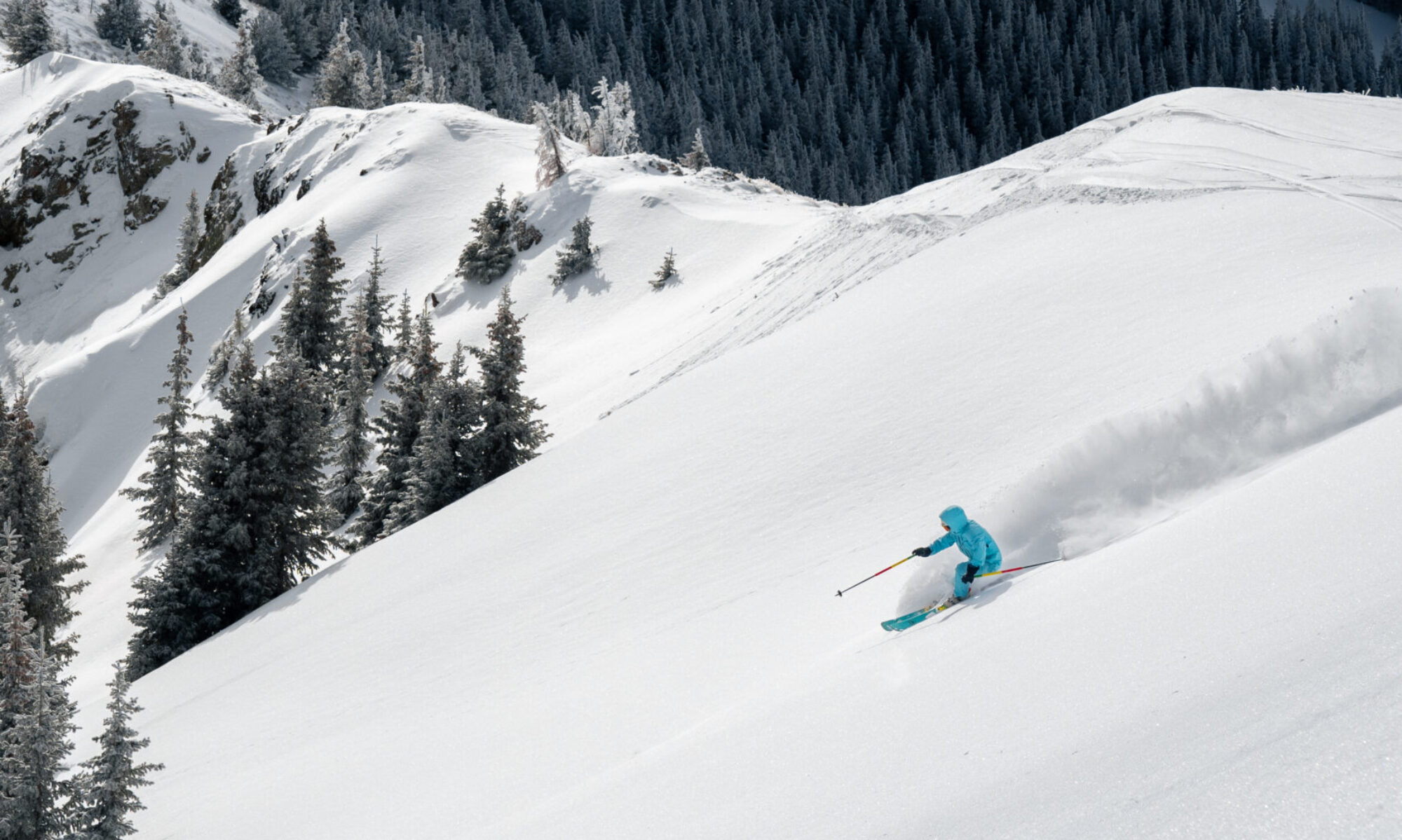Picuris Pueblo reopens its storied museum
By Olivia Lewis
At an ancestral site in Picuris, sunlight spills over the mesas as 16-year-old Braylon Quiver kneels beside a shallow pit in the earth. Dust clings to their hands as they search through layers of rock and time for remnants of their ancestors — fragments of pottery, tools, shells — each a link in a chain of memory.
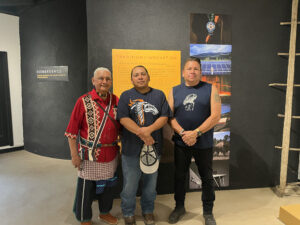
From left, Picuris Pueblo’s Joe Mermejo, Traditional Council Member and former Tribal Council member; Gov. Wayne Yazza Jr.; and Lt. Gov. Craig Quanchello, as seen at Picuris Pueblo Museum during its reopening the week of San Lorenzo Feast Day.
“What stuck with me was it made me proud to be Picuris, because these are my ancestors — this is where they farmed, they lived and this is who they were,” Quiver says.

Regalia of Picuris Pueblo, as seen during the reopening of Picuris Pueblo Museum on San Lorenzo Feast Day Sunday (Aug. 10).

Regalia of Picuris Pueblo, as seen during the reopening of Picuris Pueblo Museum on San Lorenzo Feast Day Sunday (Aug. 10).
For Quiver, archaeology means getting waist-deep in the past to preserve Picuris history. As a student, they’ve worked alongside Barnard College archaeologists to protect ancestral sites threatened by modern infrastructure projects. “We needed clarity to make sure that if we wanted to bulldoze or dig, anything there wouldn’t be disturbed,” Quiver explains.
This summer, their work came full circle with the reopening of the Picuris Pueblo Museum and Interpretive Center — a milestone coinciding with the return of thousands of artifacts excavated in the 1960s and long housed at Southern Methodist University in Taos.
“We just started bringing things back this summer,” says museum director John Galuska. “There’s a pottery collection we brought back in its entirety, and thousands of other artifacts we’re still processing.”
Reemergence of a legacy
The Picuris Pueblo Museum first opened in 1969, displaying artifacts unearthed during excavations led by Harvard archaeologist Herbert Dick. Those digs — initially tied to installing the Pueblo’s first water and septic lines — revealed the most extensive cultural deposits of any living Pueblo community in the Southwest.

Photographer Pete Longworth took myriad portraits for the museum and for the pueblo’s book, “The Story of Hotel Santa Fe and Picuris Pueblo” by Daniel Gibson.
In the 1980s, the museum even housed the Hidden Valley Restaurant, part of a plan to generate revenue independent of outside funding. But over time, the building fell into disrepair, and its collection was sent to SMU for safekeeping.

A diplomatic gift to Picuris from Indigenous Amazonians, who used parrot feathers.
Now, decades later, the museum has reemerged with a striking new exhibit, “Reemergence: Tradition and Innovation.” The dual themes reflect Picuris’ ongoing journey — rooted in ancient culture yet alive with contemporary expression.
“It’s to anchor people to history and knowledge about the origins of Picuris, then traditions, pottery and clothing,” Galuska says.

The Picuris Pueblo Museum and Interpretive Center reopened during the week of San Lorenzo Feast Day after roughly $1 million in renovations. The reopening coincides with the return of thousands of artifacts excavated in the 1960s that were on loan to Southern Methodist University Taos.
Renovations began four to five years ago with $250,000 in capital outlay funds, later bolstered by the New Mexico Tourism Department and other partners. “As the smallest Pueblo, we’re often left out,” says Lt. Gov. Craig Quanchello. “But we’re working hard to build up what so many others take for granted — like police, fire, healthcare, jobs and recreation.”
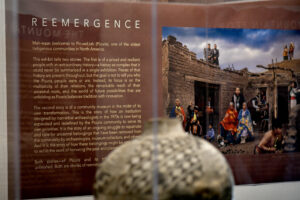
The Picuris Pueblo Museum and Interpretive Center reopened during the week of San Lorenzo Feast Day after roughly $1 million in renovations. The reopening coincides with the return of thousands of artifacts excavated in the 1960s that were on loan to Southern Methodist University Taos.
Quiver, now assistant curator, helped catalog hundreds of ancestral objects alongside Galuska and lead curator Dr. Severin Fowles, Picuris’ official archaeologist and anthropologist. “It felt like a Herculean effort,” recalls Cayla Gancy, a Barnard graduate and museum intern. “We were accessioning, labeling, weighing and creating text for the exhibit.”
A respectful reckoning
The museum’s revival also comes amid a broader shift in archaeology. For decades, institutions removed Indigenous remains and sacred objects without consent. The 1990 Native American Graves Protection and Repatriation Act (NAGPRA) required federally funded museums to return those items — though a “culturally unidentifiable” loophole long allowed many to remain in collections.
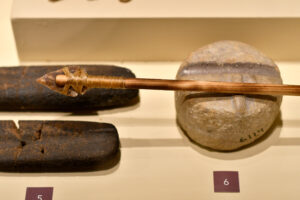
The Picuris Pueblo Museum and Interpretive Center reopened during the week of San Lorenzo Feast Day after roughly $1 million in renovations. The reopening coincides with the return of thousands of artifacts excavated in the 1960s that were on loan to Southern Methodist University Taos.
“There was a loophole in which you could just say, ‘Oh, there’s no living descendants,’ which is just patently false,” Gancy says. Recent revisions now strengthen tribal sovereignty and consultation. “At Pot Creek, the descendant groups are Picuris and Taos, and both must agree before anything can be displayed.”
For the new exhibit, curators adopted a “community-based archaeological approach.” Even small choices — leaving bags of pottery shards unsealed so they can “breathe,” or wrapping sacred objects in cloth rather than plastic — reflect that respect.
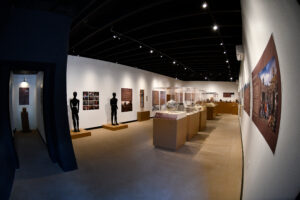
The Picuris Pueblo Museum and Interpretive Center reopened during the week of San Lorenzo Feast Day after roughly $1 million in renovations. The reopening coincides with the return of thousands of artifacts excavated in the 1960s that were on loan to Southern Methodist University Taos.
Before the public opening, tribal members previewed the exhibit in a private ceremony. “We had elders who rarely leave their homes come out,” Quiver says. “And young kids who were just mesmerized. It’s not just arrowheads in a box — it’s the story that it’s telling.”
That story continues. Picuris recently partnered with geneticists from the University of Copenhagen, confirming a direct link between living Picuris members and ancestral remains at Pueblo Bonito in Chaco Canyon.

The Picuris Pueblo Museum and Interpretive Center reopened during the week of San Lorenzo Feast Day after roughly $1 million in renovations. The reopening coincides with the return of thousands of artifacts excavated in the 1960s that were on loan to Southern Methodist University Taos.
“I’m proud that Picuris is starting to become part of this bigger picture,” Quiver says. “We’re in a time of revitalization — DNA testing, the rec park, all of these projects.”
Quiver, a fifth-generation micaceous potter, created 50 clay pieces for the museum’s opening day — all sold out by noon. They learned from their great-grandmother Cora Durand and uncle Anthony Durand, inheriting their tools and a love of the clay known as Molo nan na, the “pot dirt place.”
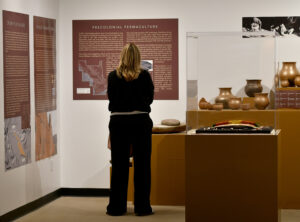
The Picuris Pueblo Museum and Interpretive Center reopened during the week of San Lorenzo Feast Day after roughly $1 million in renovations. The reopening coincides with the return of thousands of artifacts excavated in the 1960s that were on loan to Southern Methodist University Taos.
“This museum has always been a key puzzle piece in what we grew up with,” Quiver reflects. “As a kid, I’d come here for art classes. Now, I get to help tell our story — and bring it home.”
Picuris Pueblo Museum and Interpretive Center
201 Pueblo View Road, Peñasco
Open Fridays and Saturdays, 10 a.m.–5 p.m.; weekdays by appointment
museum.director@picurispueblo.org
